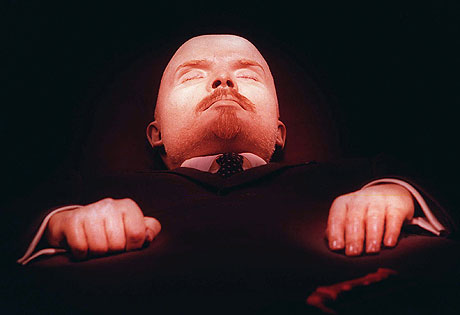 Call it the OTHER church-state controversy that is making waves in Russia right now.
A month or so ago, The Washington Times ran an interesting article about the ongoing debates in Russia about whether or not to bury the embalmed body of Soviet patriarch Vladimir Lenin. When I started reading this interesting story, I immediately thought two things.
Call it the OTHER church-state controversy that is making waves in Russia right now.
A month or so ago, The Washington Times ran an interesting article about the ongoing debates in Russia about whether or not to bury the embalmed body of Soviet patriarch Vladimir Lenin. When I started reading this interesting story, I immediately thought two things.
(1) I bet that the story misses the main ghost in this topic, which is why it is so important -- in the mind of a land haunted by Orthodox Christianity -- for the body of the Soviet leader to be seen as, well, incorrupt. As it turned out, the story saw half of the ghost, the hardest part of the ghost to see, in fact. More on that in a moment.
(2) I also saw a connection, kind of, with the Pussy Riot controversy, which is a story that -- as discussed here at GetReligion -- is both religious and political, even though the mainstream press keeps describing it as pure politics. No doubt about it, the government of President Vladimir Putin played a role in the relatively harsh sentence (compared to, let's say, Germany) given to the women in this punk-rock theater troop. However, the emotions unleashed in this case also have a lot to do with Orthodox symbolism and the Russian imagination.
You see, even for vaguely religious Russian nationalists, an altar is still and altar.
This was the subject of my Scripps Howard News Service column this week and we sifted through the embers of this firestorm this week on the GetReligion podcast, as well. Here is a crucial part of that column, featuring quotes from an online commentary by the famous historian Philip Jenkins. Concerning the Pussy Riot media storm, he said:
It's crucial that these events have unfolded in a land still struggling after a blood-soaked century that included the worst sustained persecution in Christian history. The communists closed 98 percent of Russia's churches and killed 200,000 bishops, priests, monks and nuns, while another 500,000 or more believers were sent to die in labor camps. Millions more died in purges under Josef Stalin.
Members of the Soviet League of the Militant Godless -- including Alexandra Kollontai, a self-proclaimed "female Antichrist" -- took special glee in vandalizing churches, desecrating the relics of saints and performing profane, crude, blasphemous skits in, or even on, the altars of Orthodox sanctuaries. As their ultimate act of desecration, the Soviets in 1931 leveled the Cathedral of Christ the Savior.
"Christ the Savior was a central shrine both of the Orthodox faith and of Russian national pride, and for that reason, the Bolsheviks targeted it for destruction," noted historian Philip Jenkins, author of "The Lost History of Christianity" and numerous other works, in an online commentary about the Pussy Riot case. "Not until 1990 did a new regime permit a rebuilding, funded largely by ordinary believers, and the vast new structure was consecrated in 2000. The cathedral is thus a primary memorial to the restoration of Russia's Christianity after a savage persecution."
The profane, sacrilegious skit at the holy doors of the altar in this symbolic cathedral, for many but not all Russians, seemed like an echo of the earlier era. Look at it this way: This was rather like protesters seizing a European synagogue that had been rebuilt after the Holocaust and using it as the setting for some kind of crude, vulgar video that mocked and cursed Jewish prayers.
 How would the media respond in that case? Jenkins noted:
How would the media respond in that case? Jenkins noted:
"Not only would international media fully support the governments in those circumstances, but they would complain bitterly if police and courts showed any signs of leniency," argued Jenkins. "However serious a group's grievances, there is absolutely no justification for expressing them with such mind-boggling historical insensitivity, and in such a place. Anywhere but there!"
OK, so I know what you are thinking. What does any of this have to do with that picture of the embalmed body of Lenin?
You see, the propaganda masters for the Soviet state knew that they needed to attack the church, but also to, somehow, offer symbols that could replace elements of the church in Russian hearts. Thus, Lenin needed to remain incorrupt. Why? Because the bodies of some saints, for reasons that are mysterious to say the least, never crumble into corruption. For millions of Russians, Lenin had been granted a kind of secular saint status.
These emotions continue to rumble through the Lenin-burial debates in Russia, today. Sort of like the Pussy Riot case? Sort of. I see a connection.
So what did the Times article get right, if it missed the symbolism of the incorrupt body of Lenin? To my amazement, the article ended with this commentary:
Any decision to bury Lenin would bring to an end one of the most curious episodes in Russia’s history.
Russians of all ages are familiar with the rallying cry “Lenin lived, Lenin lives, Lenin will live!” But very few are aware that it was no mere slogan: Certain Soviet officials believed Lenin would rise from the grave to inspire the world’s proletariat once more.
The construction of Lenin’s tomb was overseen by Soviet Foreign Trade Minister Leonid Krasin, a follower of the ideas of 19th-century Moscow-based ascetic-philosopher Nikolai Fyodorov, who was convinced that science eventually would conquer death. Krasin successfully argued for Lenin to be embalmed to preserve his body for future science. A subsequent statement in the state-run Izvestia newspaper said workers of the world “would not be reconciled” with Lenin’s death and would not rest until he was resurrected by Soviet scientists.
As a character in Soviet writer Andrei Platonov’s 1929 novel “The Foundation Pit” stated: “Marxism can do anything. Why do you think Lenin lies in Moscow perfectly intact? He is waiting for science. He wants to rise from the dead.”
Dead spot on. That's great stuff and a tremendous insight into the ghosts that continue to complicate life, and journalism, in the post-Soviet era in Russia.
